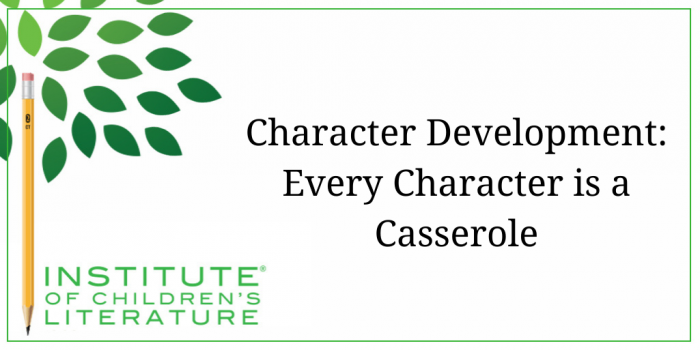1000 N. West Street #1200, Wilmington, DE 19801
© 2024 Direct Learning Systems, Inc. All rights reserved.

We teach our students how to write and get published!
View our Course Catalog >
Character creation can be approached in many different ways, but overall, most great characters come about as a mixture. Like a particularly tasty casserole, a writer grabs a pinch of this and a dash of that during the creation process. So let’s look at some of the most common ingredients in our character casserole.
I See You in There
If a writer is totally honest, they will admit that every character contains at least a tiny pinch of the writer’s DNA. That’s because we all must relate to our characters in some way or we simply won’t be able to get the character to breathe and act and react and become interesting and engaging. There will always be characters you simply cannot create well because you cannot find anything of yourself in the person, you cannot connect. So the first ingredient in the stew of character creation is always going to be you. But that doesn’t mean you think about that or ponder how to put yourself into your book. In fact, this aspect of character building usually happens with no direct intention on your part. But in the revision process, it helps to identify how the character is like you so that you can be sure the character is also completely unique from you as well.
Some Ingredients You Pick Up Along the Way
Writers are endless packrats. We find shiny bits of character everywhere we go and store them in our writerly brains to pop up when we need them most. That funny waiter who serves puns along with the meal. That boneless teenager who slouched through the mall, trailing behind a clearly weary mom. The electric toddler who asked endless questions as she rolled past you in the grocery cart while you shopped. Some writers will actively pull out a notebook and jot notes about the people who catch their eye or scribble “found” bits of dialogue overheard at the mall or the market or the library. Others merely notice these interesting characters and ponder a bit what it must be like to be that person or know that person, thus giving the person time to change from a normal human into a character in your head. Then when the time comes to create a character for a story, you can reach into your notes or your memory and mold the new character from bits and pieces of these found characters. So you might end up with a mother who uses puns to answer the endless questions of her child, making them both giggle and groan.
And Some Ingredients You Add to Grease the Wheels of Plot
The final ingredient of your character casserole comes directly from your plot. You need the sort of character who will work in the sort of story you’re brewing. One thing must be absolutely true of your story: if you change the main character (or any other vital character) substantially, the story changes substantially.
Now your story plot might really need a character who is active and decisive. But perhaps you really liked that slouching teenager whose life goal is to prove he’s not interested in anything. So you shove him into the slot. That’s the point you’re likely to find out that his passive, disgruntled nature is going to change the story. And make it harder to get your plot to work, at least to work as you originally envisioned. So, in some ways, the final aspect of character is a bit like crafting a want ad. You need to place a character in this plot to do a job. So what kind of person do you need for this job? Someone timid with a rich inner life? Someone impulsive but bright? Someone who seems unafraid of anything, except for that one secret thing? Character and plot must fit seamlessly so the final ingredient in your character building is plot. And your character choice helps bring the story and plot all together or tears it all apart. That makes it pretty important.
Think about your work in progress. Consider the plot, then make a list of the things your main character is that fit particularly well in getting the plot done. Are there any aspects that stand in the way? Are you sure you “hired” the right character for the job? Then, look at the character specifically, and see if you can tease out the aspect of the person you picked up along the way and the things that came from you, the touchstones you’re using to connect to the person. The more you think about how you put the casserole of character together, the better you can refine the recipe, and end up with exactly the right character to make your story extra tasty.
1000 N. West Street #1200, Wilmington, DE 19801
© 2024 Direct Learning Systems, Inc. All rights reserved.
1000 N. West Street #1200, Wilmington, DE 19801
© 2024 Direct Learning Systems, Inc. All rights reserved.
1000 N. West Street #1200, Wilmington, DE 19801
© 2024 Direct Learning Systems, Inc. All rights reserved.
1000 N. West Street #1200, Wilmington, DE 19801
© 2025 Direct Learning Systems, Inc. All rights reserved.
1000 N. West Street #1200, Wilmington, DE 19801
©2025 Direct Learning Systems, Inc. All rights reserved. Privacy Policy.